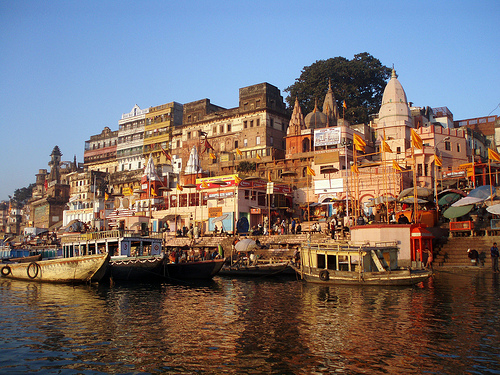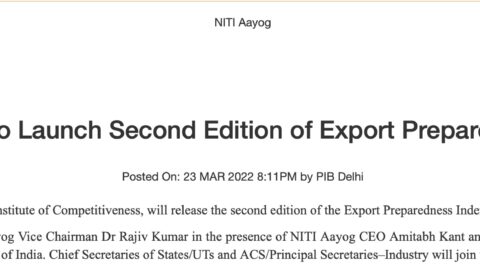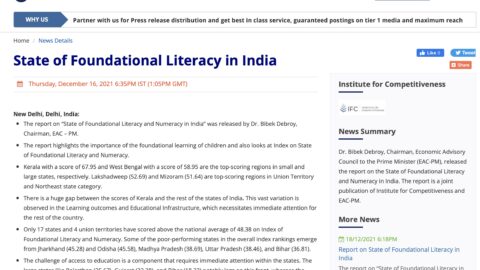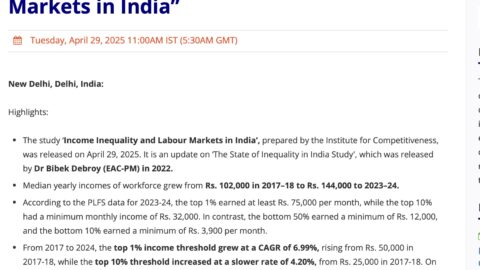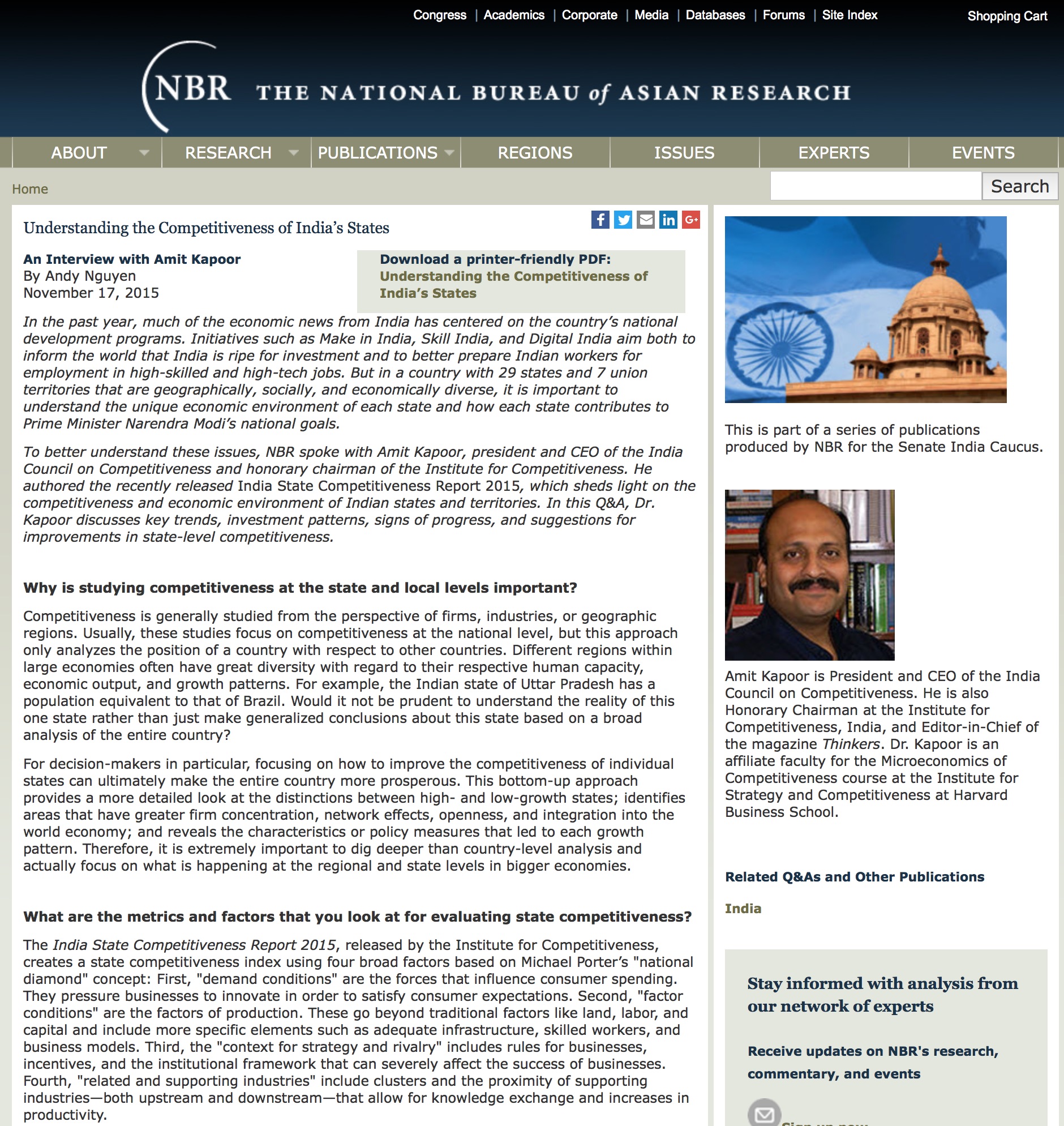The results of the India State Innovation Report 2016 wherein the report looks at various factors that have a bearing on India’s innovation environment.
New Delhi, India
Tuesday, October 4, 2016 2:20PM IST (8:50AM GMT)
Highlights:
- The report does a comprehensive assessment of the innovation environment at a state level in India.
- Aim is to look at innovation at the level of India and its states and try to compare innovation environment across states.
- Theoretical and conceptual approaches from scholars have been used to build a State Innovation Index for Indian States.
- Maharashtra emerges as the most innovative economy overall. The most innovative economies are Maharashtra, Tamil Nadu, Karnataka and Gujarat. In different categories Delhi, Uttarakhand, Goa, Sikkim and Mizoram emerge as top performers.
- Looks at the National System of Innovation in India and its performance over time.
- Another important element is discussion on Innovation at a sectoral level with innovation playing a key role in industrial development.
- Looks at different dimensions of the innovation policy and looks at some of the industrial policy architecture at a union level and in some states.
- Useful to corporates/ industry bodies and governments who seek to understand and enhance India’s competitiveness.
- Another important point is the role of FDI and liberal industrial policy regime in fostering innovation.
- Focus is not only on assessments but steps policymakers can take to enhance India’s innovation potential.
Innovation comes from the latin word innovationem which means “to change; to renew”. Innovation thus described means “a novel change, experimental variation, new thing introduced in an established arrangement”. Innovation process has been old but the discipline is relatively new.
The India State Innovation Report 2016 envisages and looks holistically at the innovation landscape of India. It broadly seeks to conceptualize, understand and look at the contours of India’s Innovation landscape. It also seeks to present a conclusion, remedial steps and changes required to enhance India’s innovation capability.
The report also has a State Innovation Index, which seeks to measure innovation environment across states in India. Categorization is done on the index according to a stage of development with eleven indicators being used for building stage of development. At the top of the Index are states like Maharashtra, Tamil Nadu, Karnataka and Gujarat. However, it must be said that these states also pale in comparison to states and regions globally which are deemed as innovation hotspots. These states have been innovative largely because some locations and cities within these states have become innovative.
Overall the index seems to tell that the innovation environment is strong regionally in south and western parts of India. Thus there seem to be a west-south and north-east divide. Delhi and Uttar Pradesh seem to be an exception to this rule and seem to be doing well on the Index. States in peninsular India seem to be doing well on innovation environment.
In various categories stacked from the most innovative to the least innovative states like Delhi, Uttarakhand, Goa, Sikkim and Mizoram emerge as the top performers.
| S. No | Categories | States | State Innovation Index Scores according to stage of Index | Ranks | Focus Areas |
| 1 | Innovation Frontrunners | Maharashtra | 49.32 | 1 | Focus on attacting more capital and identifying frontier areas for research and development |
| Tamil Nadu | 45.62 | 2 | |||
| Karnataka | 40.35 | 3 | |||
| Gujarat | 37.70 | 4 | |||
| 2 | Innovation Leaders | Delhi | 40.55 | 1 | Focus on leveraging talent and establishing more R&D centers in specific categories. Also need is to improve startup ecosystem |
| Uttar Pradesh | 37.91 | 2 | |||
| Kerala | 37.40 | 3 | |||
| Andhra Pradesh | 35.43 | 4 | |||
| Punjab | 33.94 | 5 | |||
| West Bengal | 33.01 | 6 | |||
| 3 | Potential Innovation Leaders | Uttarakhand | 30.73 | 1 | Focus on understanding unique attributes of each economy so as to enable it to become innovation leader |
| Haryana | 30.05 | 2 | |||
| Rajasthan | 28.18 | 3 | |||
| Madhya Pradesh | 26.98 | 4 | |||
| Jharkhand | 21.42 | 5 | |||
| 4 | Median Innovation Performers | Goa | 39.67 | 1 | Focus on drawing more capital and improve the science and technology education as well as trying to foster a culture of risk taking |
| Himachal Pradesh | 33.35 | 2 | |||
| Odisha | 26.26 | 3 | |||
| Bihar | 24.27 | 4 | |||
| Chhattisgarh | 23.69 | 5 | |||
| Assam | 23.49 | 6 | |||
| 5 | Potential Median Innovation Performers | Sikkim | 33.04 | 1 | Focus on capital while improving skills and maintaining a stable environment |
| Tripura | 27.15 | 2 | |||
| Jammu & Kashmir | 26.97 | 3 | |||
| Meghalaya | 22.86 | 4 | |||
| 6 | Innovation Underperformers | Mizoram | 32.47 | 1 | Focus on basic inputs of Innovation like a stable enivonment and education at primarly level |
| Arunachal Pradesh | 28.30 | 2 | |||
| Manipur | 27.40 | 3 | |||
| Nagaland | 22.75 | 4 |
Innovation as a paradigm is of huge concern for a country the size of India. It is because innovations are important from several viewpoints. These include solving certain problems in society either by companies or by individuals using innovations. Innovations are also important from the viewpoint of economic growth. Technological innovation forms the basis of industrial development and growth and competitiveness of nations. Several countries have invested greatly in R&D efforts and these have helped reap rich dividends. It is because such efforts have been instrumental in the development of inventions that lead to innovations and globally competitive industries over time.
Broad level learning and some policy imperatives at the national level include increasing the spending on R&D at a national level, improving capability of top rung educational institutions in India like IIT/IIM’s to produce greater innovation outputs. The need is also for greater coordination and collaboration between national CSIR labs and the educational institutions for enhancing innovation capability. The issue is also lack of technology transfer mechanisms between labs and industries. Another important issue at a national level is to constantly upgrading and design better laws and policies on crucial areas like industrial policy, intellectual property, foreign direct investment, etc. Another learning if for innovation to be important at a national level it takes long-term policy orientation even in the wake of newer governments. Decade long innovation policy can become a reality only with all stakeholders being convinced on innovations being central to competitive economies.
At the state level, broad level policy imperatives and key learning includes finding a balance between technology push and market oriented technology development. Another important finding is lack of linkages between state level universities, MSME’s and R&D institutions. Another important find is few policies exist that seek to improve the innovation and entrepreneurship ecosystem at the state level. Cluster development programs are also an area badly in need of greater coordination and can benefit with a more open collaborative approach. Also industrial policies at the state level need to focus more on innovation. At present few policies exist for innovation even in the most innovative states with the exception of Karnataka.
At a sectoral level some things have worked and some have not. An overarching theme is that sectors, which have seen more openness and collaboration with domestic and foreign private sector, have been able to reap rich dividends with several research labs coming up in distinct locations and the sectors becoming globally competitive over time. These include sectors like automobiles, pharmaceuticals, food processing and biotechnology. The defense production sector has had several checks both on its technology development organizations such as DRDO and its production organizations and this has had a tremendous cost. It is because India has had to import a lot of its defense equipment and this has a bearing on not just the sector being relatively uncompetitive but also in terms of the costs of procurement from outside being high. Another important point is that the teaching and research ecosystem around the sectors does have a positive impact on development of sector and sectoral innovation.
The report was launched on September 30, 2016 and is can be downloaded from http://futureofstates.in/state-innovation-report/ starting October 4, 2016.
About Institute For Competitiveness
Institute for Competitiveness, India is an independent, international initiative centered in India, dedicated to enlarging and disseminating the body of research and knowledge on competition and strategy, pioneered over the last 25 years by Professor M.E. Porter of the Institute for Strategy and Competitiveness, Harvard Business School (ISC, HBS), USA. Institute for Competitiveness, India works in affiliation with ISC, HBS, USA to offer academic & executive courses, conduct indigenous research and provide advisory services to corporate and Government within the country. The institute studies competition and its implications for company strategy; the competitiveness of nations, regions & cities; suggests and provides solutions for social problems, Institute for Competitiveness, India brings out India City Competitiveness Report, India State Competitiveness Report and funds academic research in the area of strategy & competitiveness.
Note to Editors
In case of any query please write to


